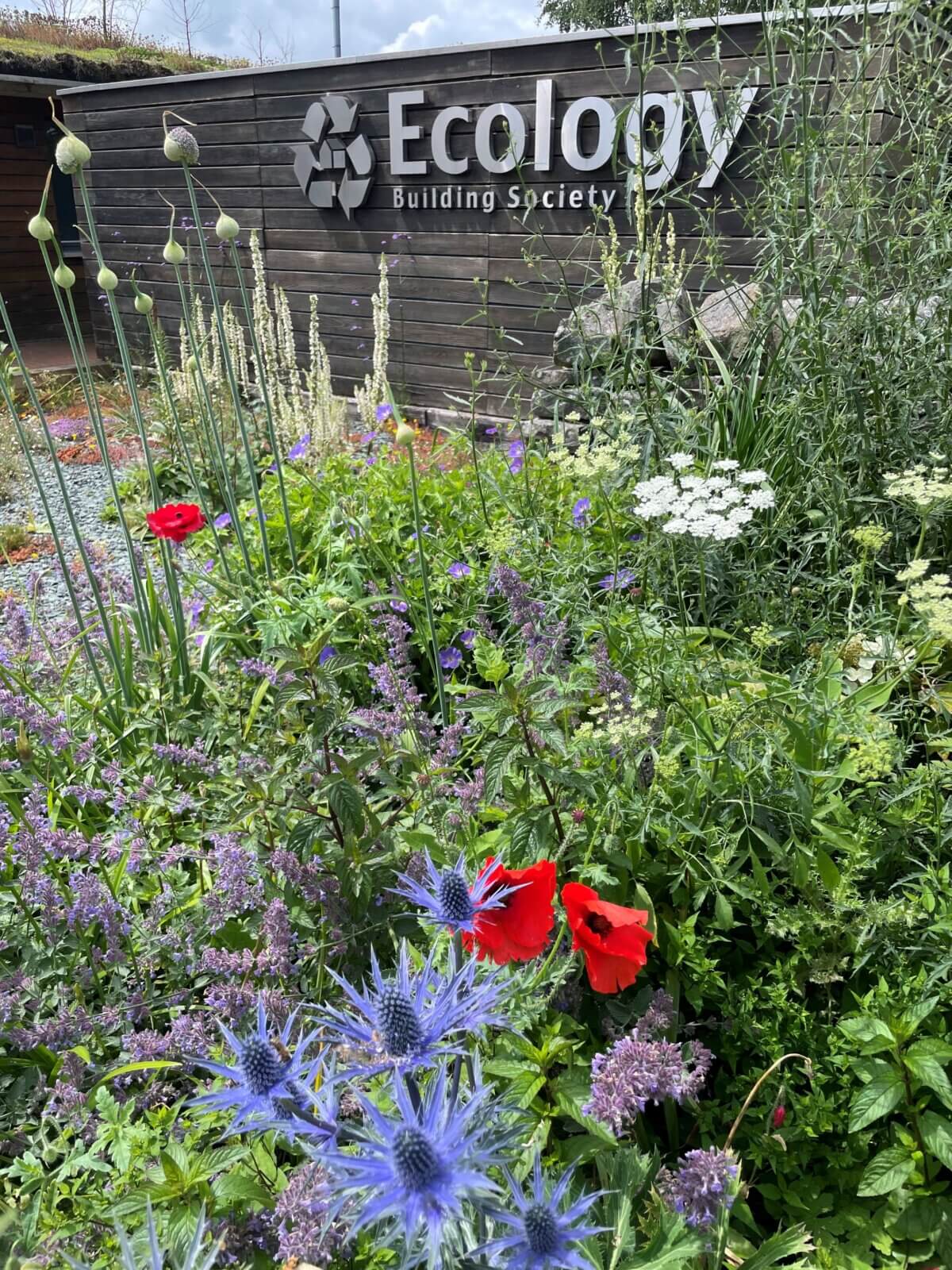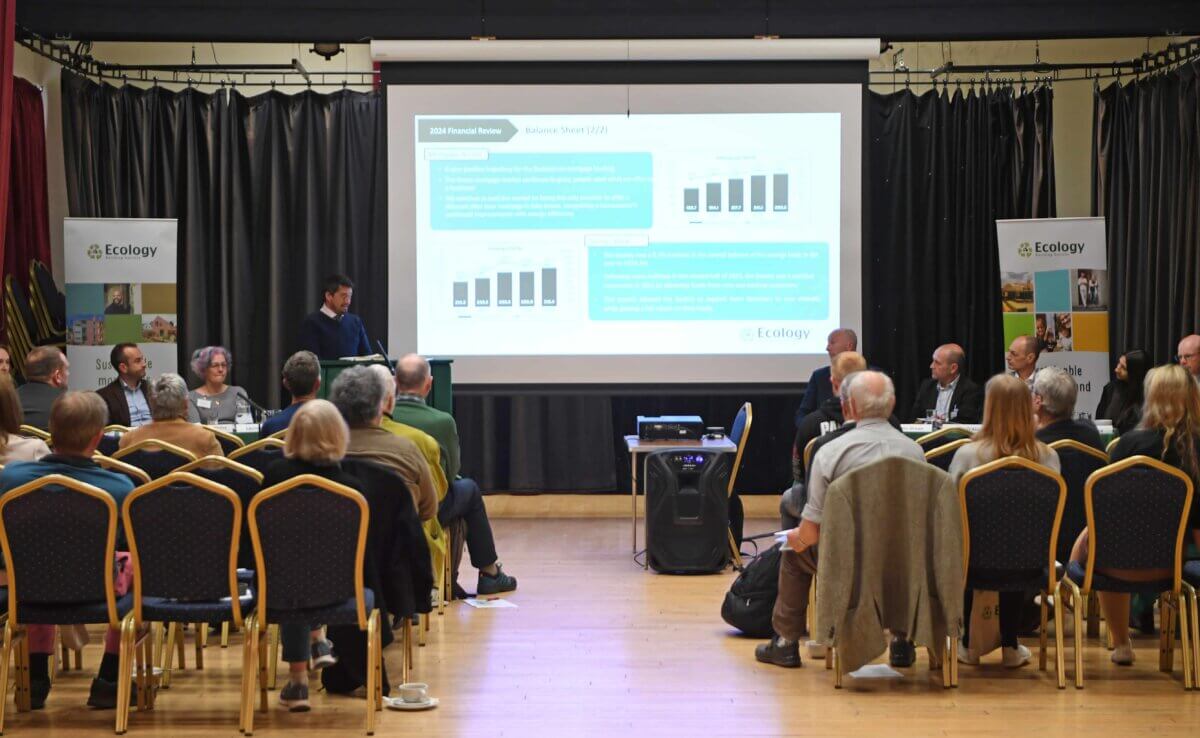Sustainable Gardening
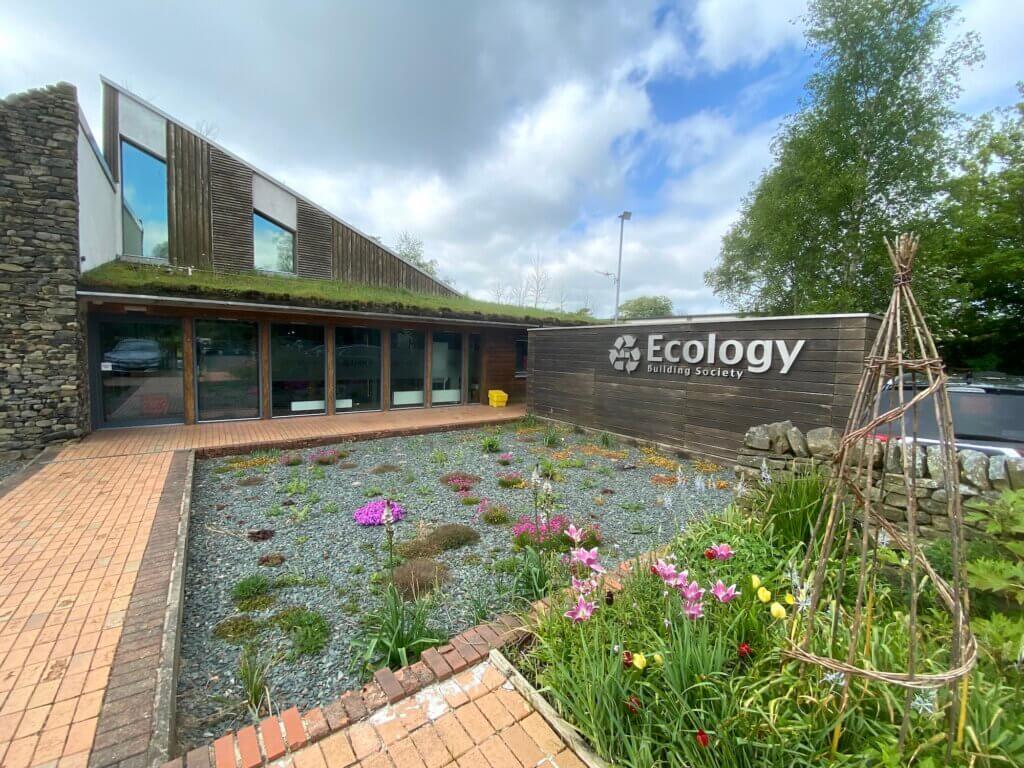
It’s a coolish overcast day at the beginning of May. The road outside Ecology Building Society’s offices is relatively quiet. Which is more than can be said for the large scrubby patch of shrubs and trees beyond the car park echoing with mellifluous birdsong: Song Thrush, Blackbird, Robin and Black Cap.
That such an unassuming plot of unkempt scrubland is palpably alive with wildlife is no mere accident. The land around the 2003 office building was always designed to encourage flora and fauna; it is a part of the original building plan. Ecology’s ethos is centred around sustainability and the environment, so where better to demonstrate this than in the land it owns?
Ecology’s land runs diagonally south-west to north east along Belton Road in Silsden with a small woodland at one end and community area with islands of shrubbery at the other, they are separated by the car park and office building around which is a garden of trees, borders and flowering plants. The original garden design document is a comprehensive 40 pages long, guided by ‘the principles of sustainability, which seek to integrate environmental with social and economic considerations’ with the aim ‘to amplify biological diversity’. Over twenty year on, these guiding principles are being carried and on and developed by Ecology’s gardeners Pippa and Andrew Chapman.
Those Plant People
Pippa and Andrew Chapman run a small garden design and consultancy business, Those Plant People, based in nearby Keighley. Committed to ecological and sustainable gardening that increases biodiversity (as well as being local) they are a perfect fit for Ecology. Pippa trained at the prestigious RHS Harlow Carr in Harrogate and Andrew used to be a senior gardener there; they are both experts in regenerative gardening and have been working with Ecology for the last five years.
“We’re a permaculture gardening business,” explains Pippa, “and that’s central to everything that we do. Including the ethics, people care and care for the environment. We wrote our business plan using the permaculture design process, so it’s embedded within our business. It fits in perfectly with what we do here. We really value the biodiversity of the garden. Everything we do is constantly trying to build on that to create a really thriving ecosystem which fits in really well with the ethos of of Ecology’s business.”
As well as getting her hands dirty with the actual gardening, Pippa also teaches permaculture, provides tours of the garden and hosted a couple of permaculture design courses for the Leeds Permaculture Network. She has written a book about forest garden design and even given a talk at Harvard University.
What is Permaculture?
Ask Pippa, ‘what is permaculture?’, her eyes widen and she replies: “What a question!”
Indeed, a single all-embracing definition of permaculture is hard to find. A dictionary definition might be on the lines of: permaculture is a form of land management that develops an ecosystem intended to be self-sufficient and sustainable. Permaculture magazine defines it as ‘an innovative framework for creating sustainable ways of living’ and ‘a practical method of developing ecologically harmonious, efficient and productive systems that can be used by anyone, anywhere.’ However you define it, it chimes with Ecology’s own mission to support and promote sustainable practices in the built environment.
As Pippa says: “I think there are so many different answers and so many people have different takes on what is permaculture. For me, I think it’s really important to remember all of the ethics. So a lot of people might do all the brilliant earth-care side of things but at the same time might be exploiting their workers, for instance. So I think it’s really important to remember the ethics we practice in permaculture, not just think of it as regenerative farming. At every point we think, where are the materials we’re using coming from? Has anyone been exploited in any part of the manufacturing distribution process? What will happen to these materials when we’re finished with them? As much as possible we try and use what’s on site. We create log piles when trees are felled and we create wood chip from our own branches, create our own plant feeds from plants within the garden, make our own compost so we’re not buying it in, sowing seeds straight into the ground and then just move them wherever we need them when they’re ready.”
On a practical level, then, permaculture is about encouraging biodiversity, gardening with nature in mind and reusing and repurposing materials already there. It’s about increasing habitat, not being too tidy, for instance, by leaving log piles and leaf piles to encourage wildlife.
A Thriving Ecosystem
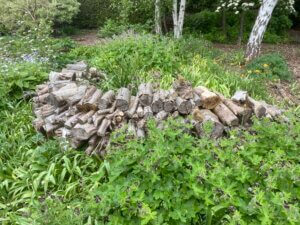
When it comes to planting, Pippa sees it very much in terms of layering plants, using the vertical space as much as possible to create a thriving ecosystem. It’s about putting plants together that will grow well together, and also thinking about plants which can increase fertility such as nitrogen fixing plants and plants for pollinators to attract the beneficial insects. “It’s very much about minimal, intervention,” explains Pippa, “If there are a few weeds in there, it doesn’t really matter. If something starts to take over, then you can intervene. But there’s also has to be some space for nature to thrive.”
When Pippa and Andrew first arrived, the garden had a lot of native plants, shrubs and trees in line with the original design document. However, there were few plants for pollinators. So one of the first things they did was increase the planting: providing more colourful flowers to bring year-round interest for pollinators while at the same time making it more attractive to the eye. In amongst the flowers there are also herbs, edible plants and even plants for making dyes. There is also an area for propagating plants which are given to community groups. As Pippa points out, ‘there are lots of plants that are easy to grow once you have them but are expensive to buy.’ Community projects also benefit from willow cuttings from Ecology’s own willow coppice hedge.
Community Gardening
Although the land around Ecology’s offices benefits both employees and wildlife, there is also a community area which was also part of the original design concept. Not a community garden as such, but an area with open access to the public. It consists of three grassy islands with shrubs, spinney, fruit trees and bushes and at the furthest end a large lime tree protected by a tree preservation order.
The community garden area, however, has had a somewhat chequered history.
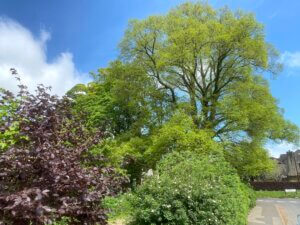
“At the moment there’s not much involvement with the community,” says Pippa, “I’ve tried to involve them more and we built a Willow Dome for children but that got vandalised. During lockdown it there was a lot of fly tipping because I think people thought it was waste ground instead of seeing it as a wild space. We tried to make the area look a bit more ‘used’ so people might realise it was a community space but with all the wet weather it became quite inaccessible because the pathways just turned to mud. Dog poo is always a problem. It drives me mad. I’ve had to build a lot of spiky dead hedges to prevent that, and I’ve got to try and open it up a bit more to make the sight lines better.”
This situation is not unique to Ecology. Our general perception of a well tended garden is one of neatly mown lawns and regimented flowerbeds. Part of permaculture land management is to allow nature to develop in its own, comparatively ramshackle, way. What looks like a scruffy or abandoned piece of land may well be a thriving and diverse ecosystem that has been carefully managed by the sustainable gardener.
For instance, Ecology’s community area not only encourages insects and birds but also includes a wide variety of fruits and herbs which people are free to come and pick themselves, including: plum, sloe and blackthorn; gooseberry, redcurrant, blackcurrant, raspberry and elderflower; also rhubarb and chives. Much of this is overlooked and it’s clear that more work needs to be done to promote the benefits of the area.
For the permaculture gardener in the community, then, the job can be as much about winning hearts and minds as it is planting the perfect herbaceous border or fruit tree. Pippa is keen to share her love of sustainable gardening and more than happy to stop and chat and answer questions to passers-by. She posts on social media and tries to engage the local community through talks at the local town hall and giving tours during the Silsden Open Gardens event.
Pippa’s long term plan is to have a community apothecary garden with a wide variety of herbs that people can come and collect if they want to make various lotions and potions.
Developing the Garden in a Time of Climate Change
Pippa and Andrew’s job is not just about maintaining the garden but actively developing it.
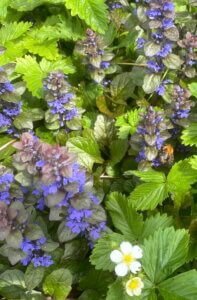
“We’re constantly changing things,” Pippa says, “adding new features, building up habitat. It’s quite a large space. There are areas we’ve entirely replanted because the planting needed watering and you can’t really have that. It’s fair enough for your annual vegetable garden but perennial plants shouldn’t need any watering; they should be drought resistant. Although this is difficult at the moment as one year we’re having a huge drought and then you have six weeks of rain.”
With increasingly milder, rainier winters and hot dry summers, the seasonal affect due to climate change is a real problem for gardeners. Pippa recognises the challenge but also knows there is no easy solution.
“I was just talking to someone who was tree planting and he says he’s gone from planting trees in a bog to turning up and finding the ground is just baked solid within the space of what, a week or two? It’s a problem. You’ve got plants that in the winter are going to be sat in water, but then in the summer there’s no water. It’s quite a challenge. It’s something that the horticultural world is looking at now. Over the last few years, for instance, everyone’s been pushing for drought resistant planting. And I’m just doing a big project where I’ve been asked to design a large scale arid forest garden. It’s meant to be a climate change garden, but then you have to ask yourself: is that even going to be the sort of conditions we’re moving to in the future? You know, when there’s flash flooding, how can you slow that water down? Even moving just through domestic-scale gardens, how can you slow water down so it doesn’t all rush straight into waterfalls? It’s complicated, and not as easy as just saying let’s grow plants from the Mediterranean.”
The Story Continues
Despite the vagaries of the British weather the Ecology garden continues to thrive and grow under Pippa and Andrew’s stewardship. There a plans to plant a living willow dome in the community area to replace the one that was vandalised and there will be more planting in the autumn.
Currently they are busy finishing planting up a food forest border and some natural dye plants. They will be adding to the stone pile and extending the log pile to encourage wildlife. Like many in the Bradford area, they have been following No Mow May. However, even at the end of May they will only be mowing the pathways. Finally, annual vegetables will be going into the raised bed in the garden area behind the office.
A garden in never truly finished. Like a novel that never quite ends, it has its own dramatic twists and turns, moving from chapter to chapter, season to season, new characters come along putting down roots, others go; but the story of nature with a helping human hand continues… watch this space!
